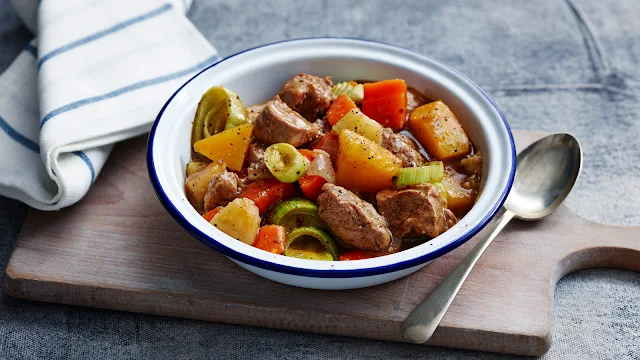Img credit: bbc.co.uk
Welsh Cawl is a hearty and traditional Welsh soup, deeply rooted in the country's culinary heritage. It's a dish that embodies warmth, comfort, and the essence of Welsh culture. Cawl has been enjoyed for generations, passed down through families and communities, evolving with time but retaining its fundamental character.
The Cultural Significance
In Wales, Cawl holds a special place as a symbol of sustenance, unity, and tradition. Historically, it was a staple meal for farmers and laborers, providing nourishment during long days of work in the fields. Today, it remains a beloved dish, often served on special occasions, family gatherings, and holidays, connecting people to their heritage and the land.
Ingredients for Traditional Welsh Cawl
Meat
The traditional Welsh Cawl recipe typically calls for lamb or mutton as the primary protein. These meats impart rich flavors and tender texture to the dish. The use of inexpensive cuts, such as neck or shoulder, adds depth to the broth as they slowly simmer, releasing their savory essence.
Vegetables
Key vegetables in Welsh Cawl include leeks, potatoes, carrots, and turnips. These hearty vegetables contribute to the soup's robust character and provide essential nutrients. Leeks, in particular, are a quintessential component, lending a sweet and aromatic flavor to the broth.
Broth
A flavorful broth forms the foundation of Welsh Cawl. It's typically made by simmering the meat and vegetables together, allowing their flavors to meld and intensify. The broth is seasoned with salt, pepper, and sometimes a bay leaf or thyme, enhancing its savory profile.
Preparation of Welsh Cawl
Cooking Meat
To begin, the meat is browned in a large pot to develop caramelized flavors. Then, water is added to cover the meat, and it's simmered gently until tender. Skimming any impurities that rise to the surface ensures a clear and clean broth.
Adding Vegetables
Once the meat is cooked, the vegetables are added to the pot. They are layered according to their cooking times, with longer-cooking vegetables like potatoes and turnips placed first. This ensures that all the vegetables are perfectly tender and flavorful by the end of cooking.
Simmering the Broth
The pot is covered, and the Cawl is left to simmer over low heat, allowing the flavors to meld and the vegetables to soften. This slow-cooking process is crucial for developing the depth and complexity of the broth, resulting in a satisfyingly rich and hearty soup.
Serving and Presentation
Accompaniments
Welsh Cawl is often served with crusty bread, such as a rustic loaf or traditional Welsh bara brith. The bread is perfect for soaking up the flavorful broth and adds another layer of texture to the meal.
Garnishing
A sprinkle of freshly chopped parsley or chives adds a pop of color and freshness to the dish, enhancing its visual appeal and brightening the flavors. Some may also choose to drizzle a bit of extra virgin olive oil over the soup for added richness.
Variations and Regional Differences
Modern Twists
While traditional Welsh Cawl remains beloved, modern interpretations abound. Some cooks may experiment with different cuts of meat or add additional vegetables for variation. Vegetarian and vegan versions also exist, using ingredients like mushrooms or lentils to replicate the heartiness of the original dish.
Regional Adaptations
Throughout Wales, various regions have put their own spin on the classic Cawl recipe. Coastal areas might include seafood such as cockles or mussels, while inland regions may incorporate local specialties like Welsh cheese or smoked meats. These adaptations reflect the diverse landscapes and culinary traditions of Wales.
Health Benefits of Welsh Cawl
Nutritional Value
Welsh Cawl is not only delicious but also nutritious. It's packed with vitamins, minerals, and antioxidants from the assortment of vegetables used. Additionally, the protein from the meat helps to keep you feeling full and satisfied, making it a wholesome and balanced meal.
Comfort Food Qualities
Beyond its nutritional value, Welsh Cawl offers comfort and solace, especially during cold winter months. Its warm and savory qualities are reminiscent of home-cooked meals and evoke a sense of nostalgia and well-being.
Conclusion
Welsh Cawl is more than just a soup; it's a culinary tradition that has stood the test of time, embodying the spirit of Welsh culture and community. Whether enjoyed on a chilly evening or as part of a festive gathering, its hearty flavors and rich history continue to bring people together, nourishing both body and soul.
FAQs (Frequently Asked Questions)
Can I use beef instead of lamb for Welsh Cawl? Absolutely! While lamb is traditional, beef can be a delicious alternative, adding its own unique flavor to the dish.
Is Welsh Cawl gluten-free? The basic ingredients of Welsh Cawl are gluten-free, but it's essential to check any added seasonings or accompaniments for gluten-containing ingredients.
Can Welsh Cawl be made ahead of time? Yes, Welsh Cawl actually tastes even better when made ahead of time as the flavors have more time to develop. Simply reheat gently before serving.
What are some vegetarian substitutes for meat in Welsh Cawl? Mushrooms, lentils, or tofu can be excellent substitutes for meat in vegetarian versions of Welsh Cawl, providing a hearty and flavorful alternative.
Are there any shortcuts for making Welsh Cawl? While the traditional method involves slow cooking, you can use a pressure cooker to expedite the process without sacrificing flavor. Just be sure to adjust cooking times accordingly.


